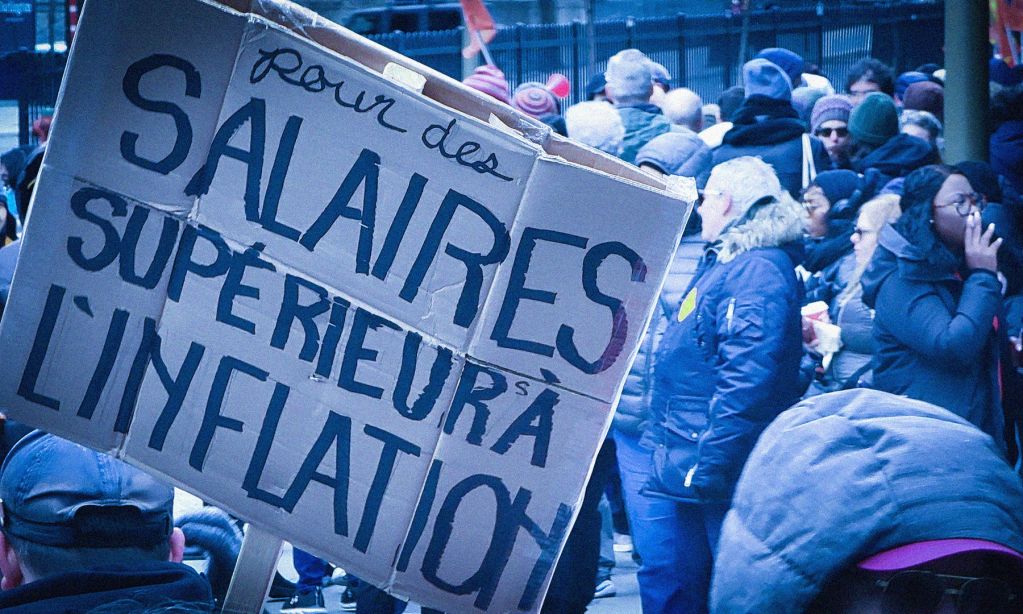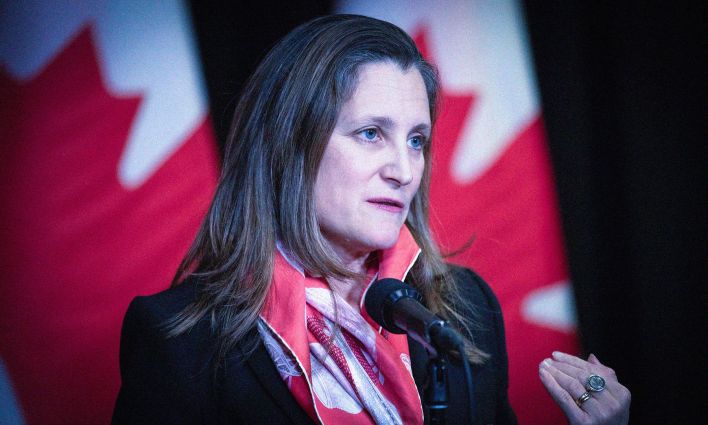Canadian federal public sector workers are on strike. At 155,000 workers, it’s one of the largest strikes against a single employer in Canadian history. The workers are striking due to major issues with pay but also remote work, job security and other issues.
These issues—particularly pay—are not unique to this sector. Understanding the underlying factors driving this strike is important, and other sectors will likely follow suit.
Inflation is a major problem for workers—it has outpaced hourly wage growth since the beginning of 2021. While the average Canadian worker’s wage has grown a bit more than usual during that time, inflation has grown a lot more, which means workers are falling behind the rising cost of living. Ever since inflation rose above three per cent in 2021, it has outpaced hourly wage growth nearly every month. Of the last 24 months—all of which registered inflation at above three per cent— wage growth has only outpaced inflation for two months, the most recent ones.
Many people are wondering when they will get relief from higher prices due to inflation—and the answer is “never.” Prices going down means negative inflation, which only happens during serious economic crises. No policy-maker is aiming for that goal—they are aiming to bring inflation down to more “normal” levels, which means slower price increases, not price reductions.
That means the only relief for workers is higher wages to afford the new higher prices. Calculating workers' wages while adjusting for inflation—particularly in the federal public sector— makes it easier to understand why workers are willing to strike over them.
Figure 2 shows inflation-adjusted wages for all workers and for the federal public sector. For both, the average weekly wages in nominal (non-inflation-adjusted) terms rose the entire time—but once adjusted for inflation, we see a huge drop in the past two years. For the federal public sector, it is so bad that they’ve lost all wage gains since October 2007. That means the average federal public sector worker’s wages only buy the same today as they did in October 2007.
No other industry—none—has seen average inflation adjusted wages pushed back as far as federal public sector workers.
Several factors are at play here. From 2008 to the pandemic, average inflation-adjusted wages did not change—meaning that raises were roughly at the inflation rate. There could also be compositional changes at play. For instance, if the federal government has been hiring more low-paid workers or laying off high-paid workers, this would bring the average down, although there seems to be little evidence of any such rapid shift over the past two years.
Federal public sector workers didn’t exactly have a build up in pay to help buffer the impact of the past two years of high inflation either. Federal sector unions haven’t even negotiated over pay since before inflation began to soar—which means those workers were locked into prior low-pay increases, which have been completely out of line with inflation since 2021.
For any worker, having their pay reduced to what they made 16 years ago is a serious kick in the teeth—especially since, in the early days of the pandemic, federal workers set up the transfer programs that saved the economy from collapse. The CERB bailed out employment insurance, the CEWS bailed out businesses, and federal workers obtained and moved the vaccines to the provinces. The government thanked those workers for their valuable public service.
The workers and the federal government are negotiating retroactive pay for 2021 and 2022, as well as wages going forward. The government is offering 1.5 per cent in 2021 and 4.5 per cent in 2022—and—the union is asking 4.5 per cent each year. But this strike is only for a third of workers that we’re looking at in the federal public service, so even with these raises, the impact overall would be muted.
With no agreement, all federal workers—not just striking PSAC members— inflation-adjusted wage gains since 2007 have been 7.8 per cent lower than the overall average (from figure 2). If the government’s position were to win in negotiations, average federal pay would remain 5.8 per cent below the industrial average by the end of 2022. If the union’s increases win, those average federal worker wages would still be 4.8 per cent below the industrial average. Of course, onlyPSAC workers are presently on strike, and other agreements could further alter the balance of power here, butit suffices to say that neither version in this specific round of negotiations would radically change the picture—federal public sector workers are being hit uniquely hard by inflation.
Of course, inflation crushing purchasing power isn’t only happening to federal public sector workers—it's happening to workers in plenty of other industries as well.
It is possible to calculate the last time wages were this low for each industry. In some industries, like real estate or accounting, wages have been rapidly going up. In those two industries, wage gains have been large enough to completely offset inflation. It should be noted that there are many accountants who also work in the federal government, although they likely didn’t see that level of increased pay.
Figure 4 shows that 21 out of 91 industries reached their most recent pay high in 2022 (the dataset used only goes to January 2023). In other words, average raises in those industries kept pace with inflation and then some. Federal public sector workers are certainly not on this list.
In many industries, inflation has driven wages back to where they stood just before the pandemic. Thirty seven out of 91 industries had their real wages decline to where they stood in 2019 or 2020. That means roughly three years of wage gains evaporated with the rising cost of living. Federal public sector workers aren’t on this list, either.
Sixteen out of 91 industries saw inflation drive their real wages back to where they stood in 2014 or even earlier. Generally, these are industries where wages were not keeping pace with inflation even before the recent price hikes, which have driven wages even further behind.
This final group of industries—the hardest ones hit by inflation in the entire economy—is where federal public sector workers are. And they’re at the very bottom of that pack.
Figure 5 shows the last time real wages were this low, by industry. As noted above, federal government public administration workers have seen their inflation-adjusted pay pushed back more than any other industry—marginally worse than gasoline stations, hospitals and K-12 schools.
No wonder there is a health care crisis: workers' inflation-adjusted pay has been cut back to what it was in August 2008. This could also mean that the federal workers’ strike is just the tip of the iceberg of broader public sector strife. Even in the private sector, most industries have lost at least two years’ worth of purchasing power to inflation.
If the first stage of the post-pandemic recovery and reopening was characterized by corporate Canada stuffing its pockets with profits as prices skyrocketed, the second stage is going to be characterized by workers fighting to regain their purchasing power through wage gains. That’s how we need to understand the current federal public sector strike.
That attempt by workers to rebalance the equation is going to come in the form of strikes and labour disruptions in the private and public sectors for years to come. It is essential that policy-makers address this issue and work towards a solution that benefits workers across all sectors. Public sector workers aren’t responsible for inflation, but they are trying to regain their lost purchasing power.







